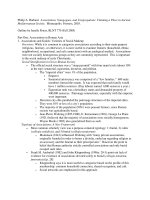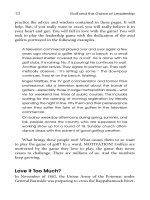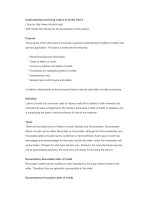Tài liệu Golf and the game of leadership 16 pptx
Bạn đang xem bản rút gọn của tài liệu. Xem và tải ngay bản đầy đủ của tài liệu tại đây (207.05 KB, 10 trang )
140
Golf and the Game of Leadership
Who can forget the final words of Todd Beamer’s cell phone
call, ‘‘let’s roll,’’ as he and others moved to successfully stop the
terrorists aboard American Airlines Flight 93?
Who can forget Michael and Roselle, who worked on the 78th
floor of the World Trade Center? After the planes struck, they
descended 78 flights of stairs to safety. As Michael said in a televi-
sion interview, ‘‘we saved each others lives.’’ Their long-time mu-
tual support was never more in evidence. Michael, a blind man,
and Roselle, his guide dog, were never closer.
Who can forget the mental image of New York City fire fight-
ers going into the burning World Trade Center and heading ‘‘up
the stairs.’’ Courage at its ultimate best!
According to Peggy Noonan, writing in the Wall Street Jour-
nal, ‘‘Brave men do brave things. After September 11 a friend of
mine said something that startled me with its simple truth. . . . He
said, ‘‘Everyone died who they were. A guy who ran down quicker
than everyone and didn’t help anyone—that was him. The guy
who ran to get the old lady and was hit by debris—that’s who he
was. They all died who they were.’’
2
Their decisions were based
on their courage, or lack of it. Their courage was based on their
values.
The Willingness to Risk
On ࠻9 we referred to Peter Koestenbaum’s Leadership: The Inner
Side of Greatness. Koestenbaum writes:
Courage, as a dominant strategy, or dimension, for acquiring
the leadership mind, is the willingness to risk. Security . . .
lies only in your courage and your character, not in dubious
guarantees from the world of business or government or pri-
vate life. The courageous leadership mind understands that
you cannot live life without courage. To lead is to act. To have
the courage to take charge, first of one’s own life. . . . Then
you are ready to take charge of organizations.
3
Observations of Courage in Action
We have played 11 holes of the Global Leadership Course to this
point. We have seen courage in action on virtually every hole
10589$ CH12 02-23-04 16:45:23 PS
141
Courage
we’ve played. On ࠻3 we saw Meg Mallon report a penalty on
herself at the cost of disqualification from an LPGA tournament
she was leading.
And, on the same hole, we observed a high school golf coach
relinquish a state championship when he noted, and reported, a
scoring error.
On hole ࠻4, we tried to imagine the depth of courage re-
quired to act by the ‘‘whistleblowers’’ Cooper, Rowley, and Wat-
kins. Also, on ࠻4 we commented on the difficult decisions leaders
are required to make to survive in difficult times. Owens-Illinois
Inc. cut its worldwide workforce of 80,000 to less than half to
manage a takeover and save the company and the jobs of the
remaining employees.
Coming down the 5th fairway, we mentioned Neil Arm-
strong’s moon landing adventure, in contrast to the human trag-
edy of the World War II concentration camps and the courageous
spirit of Viktor Frankl. Back on the ࠻6 tee, Bob Dorn stood up
and told a group of executives that they, and he, had to change
their ways: Survival of the world’s largest corporation was at stake.
How many of us would have been able to survive Bill Nie-
hous’s ordeal of being held captive in the jungles of Venezuela for
three years, as noted when we played ࠻7? We’ll read more about
Bill’s courage when we play ࠻17. On ࠻8, we observed a leader
reporting back to his colleagues that the system they as manage-
ment had put in place, and not paid attention to, was the cause of
growing customer complaints. It was not the production workers
or front-line supervisors whom they had been blaming, but it was
they themselves who were the root cause of the problems. One
leader had the courage to stand up, and speak up!
A favorite of mine is the pilot mentioned on hole ࠻9 who
simply, and directly, took responsibility before the board of in-
quiry into his plane’s crash by saying, ‘‘I screwed up.’’ Also, on
࠻9wereflected on the corporate courage of Johnson & Johnson’s
response to the Tylenol scare on the macro scale and a young
Navy lieutenant’s acceptance of responsibility on the micro scale.
When playing the 10th hole, we observed a human resource per-
son maintain her professional confidence with the CEO in the
10589$ CH12 02-23-04 16:45:24 PS
142
Golf and the Game of Leadership
face of pressure from her boss. Finally, on ࠻11, I still wonder
whether Tiger would have the courage to play Stevie at night!
There will be more examples of leadership courage as we fin-
ish our round. Look for Buck Lipton and Stan Hensley on ࠻13,
Bruce Edwards on ࠻16, more on Bill Niehous and also Ernest
Shackleton on ࠻17.
Stay Calm, Cool, and Collected
Golfers face the potential for despair in attempting to avoid or
overcome the dangers of the golfing environment. Often they lose
strokes and raise their scores but rarely stomp off the golf course
in disgust. Rather they shake off past misfortune and play on.
Sammy Rachels, first-time winner on the Senior PGA Tour at the
2001 Bell South Senior Classic on June 3, 2001, is quoted as say-
ing, ‘‘Golf is 80 percent mental and 20 percent psychological.’’
Just as the successful golfer maintains control, so too the leader
must exercise control and remain calm, cool, and collected. This
is the required state for assessing risks and handling crises most
effectively.
An Opportunity to Be Courageous
Golfers, professional and amateur alike, are upset when they per-
form poorly on the golf course. Professionals, more times than
not it seems, will finish a round in which they feel they could have
played better and immediately head for the driving range or the
putting green. Their objective is to iron out the flaw they have
detected in their game. Amateurs may not practice immediately
after playing but they will replay their round in their mind. They
will review missed shots, poor club selection, and any other mis-
takes they think they made and what they might do differently
next time out so that they can play and score better. Some, myself
included, will make notes on how to improve and put them in
their golf bag for reference before the next tee time. Professional
and amateur golfers will not tolerate their own poor golfing per-
formance if there is anything at all they can do to improve it. In
contrast, it too often seems that leaders fail to work on a remedy
10589$ CH12 02-23-04 16:45:25 PS
143
Courage
for their own poor performance. They do not reflect on the out-
comes of projects, meetings, or events in the same thoughtful,
analytic, improvement-seeking manner of the dedicated golfer.
Thus remedies for poor performance or understandings of what
works are lost.
An example of poor leadership performance that concerns me
is the way in which leaders too often deal, or more accurately
fail to deal, with a poor performer in their area of organizational
responsibility. One specific area of concern is the poor performer
with established years of service. People attending leadership ses-
sions complain that these people don’t carry their share of the
load. Further, they claim they can’t do anything about them.
Remember on the previous hole, ࠻11, we said if the leader
exhausts all possibilities to enable follower success and the fol-
lower still fails, then the follower is responsible for the failure. At
this point, the leader needs to exhibit courage, meet his or her
responsibilities to the organization and to the nonperformer’s col-
leagues, and take appropriate action. Managers—note I didn’t say
leaders—argue that they can’t get this job done. Apparently they
prefer to suffer the poor performer, lay more work on his or her
colleagues, blame human resource policies or the union agree-
ment, and set the example for others that poor performance is
okay, rather than take some very basic steps to resolve perform-
ance issues.
Whether people have simply fallen off the performance
wagon, been transferred to you under the disguise of stellar per-
formance ratings, or determined that they have enough years of
service to make themselves fire-proof and can coast into retire-
ment, you’ve got to have the courage to put a stop to their behav-
ior. As William F. Buckley once said on the Larry King television
show, ‘‘If it is unacceptable behavior, how can you accept it?’’
Further, to do so will put your organization on the road to medi-
ocrity.
What to Do?
Early in the round, we said leadership, like golf, is a simple game,
and that its essence, like that of golf, is skilled execution of key
10589$ CH12 02-23-04 16:45:26 PS
144
Golf and the Game of Leadership
fundamentals. On ࠻6, we said leaders should always focus on the
situation, issue, problem, decision, or behavior, and not on the
person. Later, as we played ࠻8, we said leaders must deal with the
facts and not with their feelings. The facts of poor performance to
expectations require implementation of a ‘‘performance improve-
ment plan’’ for the poor performer.
As a leader, you need to go back to the beginning. You need
to level with your employee. Performance expectations must be
re-affirmed and their clarity ensured. Realistic timetables for a
return to improvement should be laid out including a schedule
for progress reviews. The employee must understand that the
process has only two possible outcomes: one, a return to accept-
able performance, or two, removal from the assigned responsibili-
ties, including the possibility of termination of employment. This
process should be witnessed and all parties should literally sign off
on the plan. Both the employee and the leader must work to make
the plan succeed if at all possible. Look at it this way, as the leader
you are trying to protect an organizational human resource in-
vestment and avoid the high costs of bringing on a replacement.
In my experience, when the above action steps are taken, the
chances for the employee’s return to an acceptable level of per-
formance are very good. It’s the ‘‘no one ever explained my situa-
tion to me in this way before’’ reaction. And if poor performance
continues, the leader is justified in taking the appropriate action
to remove the employee from the assigned responsibilities. The
organization, the leader’s team, and the poor performer will have
been treated fairly and responsibly. And courageously!
Every Day Courage
Courage in the golfing sense is demonstrated by the golfer at vari-
ous times during any 18-hole round. Opportunities for leaders
to demonstrate courage in the organization environment occur
virtually every day. They involve the opportunity to do the right
thing, make the right decision. They don’t make the headlines but
have great impact on organization success and failure. Here are a
few additional examples of every day leadership courage.
10589$ CH12 02-23-04 16:45:26 PS
145
Courage
Just Say No
The department head told the accountant, ‘‘I want to install an
upgrade to our network to include wireless connectivity through-
out the facility.’’
The accountant replied, ‘‘You can’t buy it now. There’sno
money in the capital expenditure account to do it. We have no
discretionary funds available for that purpose. We would have to
take money from other dedicated operational accounts.’’
‘‘I don’t care, I need it. Other facilities have it and I want it.
Take the money out of operating expense or find it somewhere
else,’’ said the irate manager.
‘‘Look, I’ve checked purchase alternatives and talked with the
comptroller. We shouldn’t do it. If you are directing me to do it
anyway then put it in writing!’’ said the accountant.
The department head called the comptroller and got the same
response from her that he’d gotten from the accountant. He
dropped the request for purchase,
Subsequently, the accountant, on his own initiative worked
up a lease-to-own arrangement for the switching equipment. It
cost a little more over time but fit into the budgetary constraints.
The department head was pleased.
The accountant had the courage to say no and exercised the
responsibility to seek an alternative solution.
A Challenge
I remember a discussion with a group of leaders on the subject of
‘‘challenging the boss.’’ One of the leaders argued that we need to
redefine the relationship between boss and subordinate. What he
said was, ‘‘People should challenge their bosses with the question,
‘why do you require me to do these wasteful things?’’’ It is an
interesting question. Perhaps we could turn it around a bit. Why
not ask your team to express their view of wasteful things you and
they are required to do? Share those views and your own with
your boss. Encourage your team to continually speak up about
wasteful activity. They may be right. If not, it points up the need
for clarification of why questioned activity is important.
10589$ CH12 02-23-04 16:45:27 PS
146
Golf and the Game of Leadership
Not a Popularity Contest
The only woman member of the golf club’s board had been ap-
proached by a majority of the women golfers to arrange for the
moving of the tee forward and to the top of a hill on a long par 5
hole. Subsequently, the concerned women sent a letter to the club
president requesting the change. During a board meeting, after a
great deal of discussion and argument, the president asked for the
woman board member’s opinion. She said, ‘‘The tee should be
located where it best serves the interest of all members of the club
regardless of gender. Leave it where it is.’’ The tee did stay where
it was. The woman board member’s input to the board was not
popular with many of the women golfers. She knew it wouldn’t
be when she expressed her view but thought it was the right thing
to do.
Now let’s look at courage’s close cousin, ‘‘guts.’’
Now This Took Guts!
My nephew, Michael McHugh, recently retired after thirty
years of service in the U.S. Navy. All of his assignments had
been as part of the submarine force. Captain Mike gradu-
ated from the Naval Academy. As a final step to being ac-
cepted into the navy’s nuclear submarine program, he
was interviewed by Admiral Hyman Rickover, the ‘‘father’’
of our nuclear navy. This interview was required of all officer
candidates who had passed all other selection hurdles.
Admiral Rickover, by reputation, was an irascible, no-non-
sense, blunt, pragmatic workaholic, ‘‘who took no pris-
oners.’’
Mike passed his interview with the admiral. After all, he had
an engineering degree from the Academy. He’s person-
able, disciplined, and deferential, and one could easily see
why he had no difficulty meeting and being accepted by
the admiral.
However, another applicant faced a much more difficult
interview with Admiral Rickover. As Mike relates, another
10589$ CH12 02-23-04 16:45:27 PS
147
Courage
young ensign reached the final interviewstage, the meet-
ing with the admiral. This officer was not a Naval Academy
graduate.
As the young man entered the admiral’s Pentagon office
and came to attention in front of Rickover’s desk, he noted
the amount of work stacked in piles all across the massive
desk. While the ensign stood at attention, Admiral Rickover
leafed through his personnel file and then, abruptly looked
up and said, ‘‘What are you doing here?’’
Before the young officer could answer, Rickover said,
‘‘You’re not an engineer, you’ve got a degree in psychol-
ogy! Why would I even think of accepting you into the nu-
clear program? All that psychology bunk and I’ll bet you
couldn’t even make me mad!’’
The ensign, obviously surprised by the admiral’s behavior,
nonetheless maintained his military posture as he gazed at
Rickover. Several long seconds passed. Then the ensign
broke his stance of attention, walked over to the end of
the admiral’s desk, extended his right arm and in one great
sweeping motion cleared everything off the desk: papers,
folders, pictures, letter openers, pen set, nameplate, etc.!
Before the last paper had settled to the floor, Admiral Rick-
over, in what Mike describes as one indiscernible move,
vaulted from his chair to a standing position on his desk. He
was totally outraged! And he ordered the ensign out of his
office.
Subsequently, Admiral Rickover, approved the ensign’s re-
quest for assignment to the submarine force and training
as a nuclear submarine officer.
The ensign’s decision and action took a lot of courage in
addressing the admiral’s challenge. Admiral Rickover con-
firmed his own integrity by honoring that expression of cour-
age and accepting the young officer.
Obviously, the ensign and the admiral illustration is not com-
monplace. Unfortunately, in my experience neither is the expres-
10589$ CH12 02-23-04 16:45:28 PS
148
Golf and the Game of Leadership
sion of individual leadership courage. Simply put, leadership
courage is about doing what is appropriate and right and having
the ‘‘guts’’ to act.
Another Short Self-Assessment
Back on hole ࠻4, Play by the Rules, you had the opportunity to
assess yourself on leadership ethics. I suggest you score yourself
again, this time on some of the leadership skills associated with
‘‘courage.’’ Use Figure 12-l as your scorecard. As with the ‘‘ethics’’
self-assessment, follow a forced distribution to score yourself, i.e.,
rank order the skills from 5 (most effective) to 1 (least effective).
Your scoring will provide a measure of relative effectiveness on
these skills.
Once again, if you have scored yourself, it was probably diffi-
cult to work out the forced distribution. Hopefully, the process
generated some insight into your quest to be a courageous leader.
As with the ethics assessment, you may wish to ask others to rate
you, using the same forced distribution. Any difference between
their perception of your leadership courage and your own evalua-
tion is important for you to know and analyze.
Center of Moment
The ‘‘center of moment’’ is a nautical term. It refers to that precise
moment at which a vessel reaches the point in a rolling motion
when it will either right itself or capsize. Life for the leader is
full of these ‘‘centers of moment.’’ Courage is required to address
them.
Courage causes the real leader to do the right thing when
confronted by being in the right place at the wrong time or the
wrong place at the right time. The real leader is not afraid to be
exposed, overcomes the uneasy feeling when walking among the
enemy, and does not fail to lead because there is too much ‘‘work’’
or too many other ‘‘organization things’’ to do.
10589$ CH12 02-23-04 16:45:28 PS
149
Courage
FIGURE 12-1.
Sample leadership courage assessment.
As a leader, I:
Make hard choices and address difficult situations.
Stand alone when needed.
Take necessary corrective actions.
Remain cool under fire.
Take risks willingly.
Using a forced distribution, rank order the skills from 1 (least
effective) to 5 (most effective), according to the following
leadership effectiveness scale:
1—Least effective
2—Less effective
3—Acceptable
4—More effective
5—Most effective
S
OURCE
: Adaptive Leader Consulting Associates, Ltd., Adaptive
Leader Skills Assessment. Copyright 1994.
What Political Game Do You Play?
In the organizational environment, the situations you confront
may seem inconsequential and not related to courage. First, allow
me to say, all the actions of a leader are consequential. Now, let
me ask, do you have the courage to avoid behavior such as the
following:
■
Maneuvering situations and people for personal advantage
or gain?
■
Currying the approval of those in power?
■
Shading the facts to your benefit?
■
Being the proverbial yes-woman or yes-man?
10589$ CH12 02-23-04 16:45:29 PS









